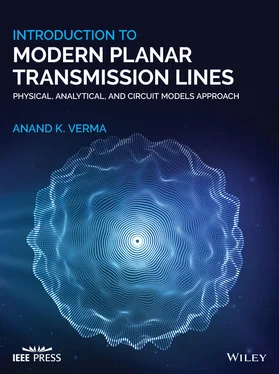Basic Planar Lines and Resonators
The planar line structures – microstrip, CPW, and slot line are discussed in chapters 8– 10, respectively. The chapters 11and 12cover the theory of the coupled transmission lines and their realization and analysis in the planar technology environment. The theory of resonating structures and planar lines version of the resonators are discussed in chapters 17and 18, respectively. The fabrication technologies – MIC, MMIC, MEMS, and LTCC used in the planar lines and components are reviewed in chapter 13.
The microstrip is the most commonly used planar line in planar technology. It is in the inhomogeneous medium supporting the hybrid‐mode that is approximated as the dispersive quasi‐TEM mode . However, at the lower frequency, it is treated in the nondispersive static condition. Chapter 8introduces the concept of medium transformation from the inhomogeneous medium to the homogeneous medium using Wheeler's transformation for the lossy microstrip medium. The results on the static microstrip line parameters are summarized. The dispersion law is discussed to get the dispersion model of microstrip. Some other dispersion models are also summarized. The losses and their computation are presented in detail. Finally, chapter 8ends with the circuit model of the microstrip line giving the complex frequency‐dependent characteristic impedance and propagation constant. The circuit model explains the behavior of the low‐frequency dispersion due to the finite conductivity of the conductors. Several topics are covered for the first time in a book form. The derivations of some frequently used expressions are provided.
The coplanar waveguides (CPW) and the coplanar stripline structures (CPS) and their variations are discussed in chapter 9. The approach used in this chapter is based on the detailed derivation of the results using the conformal mapping method . Usually, the available books only summarize the results of the conformal mapping method. However, chapter 9briefly presents the conformal mapping method as applied to the CPW and CPS. The characteristics of the modes, dispersion, and losses are presented in detail. The results are also presented for the synthesis of the CPW and CPS line structures. Finally, the circuit models of the lossy CPW and CPS are given to get the frequency‐dependent complex characteristics impedance and propagation constant.
The modeling of the third important planar line, i.e. the slot line is presented in chapter 10. The modeling process is based on the unique waveguide model of Cohn. The model provides the frequency‐dependent characteristic impedance and propagation constant of the slot line, supporting the hybrid mode. The waveguide model of the slot line treats the hybrid‐mode as a linear combination of the TE and TM modes. The equivalent waveguide model is further extended to the multilayer and shielded slot line structures. The chapter ends with the closed‐form integrated model of the slot line to compute the dispersion and loss parameters.
The next two chapters 11and 12cover the basic characteristic of the coupled lines theory and implementation of theory in the planar technology. Chapter 11discusses the coupling mechanism and the analysis of symmetrical and asymmetrical coupled lines. The wave equation of the coupled transmission is obtained and solved in some cases. Chapter 12summarizes the design expressions for the edge coupled and broadside coupled microstrip lines. Similar expressions are also summarized for the coupled CPW line structures. The network parameters for both symmetrical and asymmetrical coupled line sections are discussed in detail. Such an analysis is useful for the design of the filters.
At this stage, the further discussion of the planar line structure is discontinued and the fabrication technologies suitable for the planar lines and components are introduced in chapter 13. The chapter 13discusses, in brief, the four kinds of fabrication technologies – the hybrid microwave integrated circuit (HMIC) suitable for the PCB board medium, the semiconductor based monolithic MIC (MMIC) technology, the silicon‐based micro‐electro‐mechanical systems (MEMS) technology, and the ceramic tape‐based low temperature co‐fired ceramic (LTCC) technology. The typical details of the material and conductor parameters used in these technologies are also summarized. The familiarity of the fabrication process could be useful to the researchers and designers developing planar lines models and circuits.
The basic discussion and basic analysis of the resonator circuits, lumped and distributed line type, are presented in chapter 17. The implementation of the theory of transmission line resonators, and also the patch resonators, is the subject matter of chapter 18. The emphasis is placed on the circuit modeling of the resonating structures. Chapter 18also discusses the fractal resonators and the dual‐mode resonators with the illustrative examples of their applications. The resonating structures are important components for the development of the planar EBG and metamaterials.
Most of the discussions on the planar transmission lines and resonators are centered on the physical models and closed‐form expression using circuit modeling. However, the analytical and quasi‐analytical methods have been developed in the literature for more versatile and accurate modeling of the planar line structures in the multilayered medium. The conformal mapping method , as applied to the CPW and CPS line structures, is presented in chapter 9. The chapter 14presents the static variational methods , both in the space‐domain and Fourier domain, for the analysis of the microstrip and coupled microstrip. Using the transverse transmission line (TTL) technique , the variational method is extended to the multilayer microstrip lines. The method is extended to the boxed microstrip line and CPW using the Galerkin's method. However, the planar lines are both lossy and dispersive medium. The closed‐form models are normally not available for the multilayer lossy planar lines. Chapter 15presents the scheme of the single‐layer reduction (SLR) formulation that utilizes the variational method and available single layer closed‐form expressions to compute the dispersion and losses in the multilayer planar lines. The SLR models could be incorporated in the microwave CAD packages for the synthesis of the planar microwave components in the multilayer environment. Finally, the semi‐analytical full‐wave method, i.e. the dynamic SDA is elaborated in chapter 16. The treatment is at the introductory level with the detailed derivation of expressions. The method also incorporates the multilayered planar lines.
Contemporary Engineered Planar Structures
These are the topics of current interest and have wide‐ranging applications in the development of novel devices and antenna structures with controlled functionalities. Chapter 19is dedicated to the periodically loaded transmission lines and their circuit models. The method of the circuit models based analysis of the electronic band‐gap (EBG) line is elaborated in detail and applied to the loaded microstrip and CPW line structures. The method is extended to the planar EBG surfaces in chapter 20. The accurate circuit model of the EBG surfaces is presented, and also the process of the EM‐simulation and interpretation of the results are discussed.
The analyses of the engineered artificial media called the bulk metamaterials, metalines, and metasurfaces are presented in the chapters 21and 22. The modeling and parameter extraction of the engineered media are also discussed. The metasurfaces are interesting structures with several possible applications both in the development of the circuits and planar antenna with multidimensional functionalities. The unique generalized Snell's laws are discussed in chapter 22that helps to control the wave propagation. The polarization control and conversion of the state of polarization of the incident waves are also achieved with metasurfaces. Several applications of the metasurface are summarized.
Читать дальше












